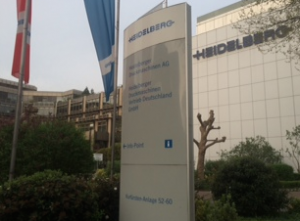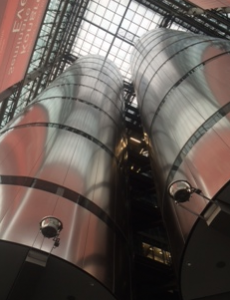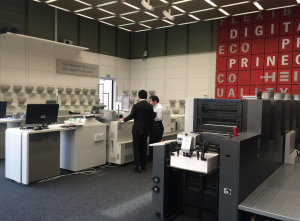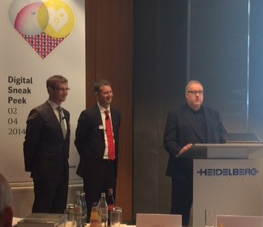By Andy Slawetsky, President, Industry Analysts, Inc.
It was my first time visiting the Heidelberg facilities in Heidelberg Germany and it was quite an impressive show. A conservative production printer manufacturer, there has been a lot of discussion in the analyst community about Heidelberg’s slow transition to digital.
 Known for massive printing presses, or what we affectionately refer to as “big iron,” Heidelberg has been a staple in high-end production printing for decades. As the industry has been shifting to digital and trends like print on demand, variable data printing (VDP) and transpromo have continued to catch on, Heidelberg has arguably struggled to keep up with competitors.
Known for massive printing presses, or what we affectionately refer to as “big iron,” Heidelberg has been a staple in high-end production printing for decades. As the industry has been shifting to digital and trends like print on demand, variable data printing (VDP) and transpromo have continued to catch on, Heidelberg has arguably struggled to keep up with competitors.
One issue behind some of this is the continued push by traditional copier companies (such as Canon, Konica Minolta, Ricoh and Xerox among others) into the light production market – a market where Heidelberg’s homegrown offerings are a bit too robust. Indeed the laser-based products from these manufacturers are in some ways more capable and considerably less expensive to buy, own and operate than Heidelberg’s own presses.
Heidelberg is a proud, old school German manufacturer and for whatever reason, they seem to have shied away in the past from partnerships, particularly with “some-time” competitors; until recently. About three years ago, Heidelberg did something very “un-Heidelberg-like” and reached out to Ricoh to rebrand their color digital presses under the Heidelberg label.
 The collaboration has yielded great benefits to both companies with over 400 Linoprint C digital printing systems (Ricoh devices) sold to date. Instead of trying to reinvent the wheel as they have typically done in the past, they went out and partnered with someone that already makes really good wheels.
The collaboration has yielded great benefits to both companies with over 400 Linoprint C digital printing systems (Ricoh devices) sold to date. Instead of trying to reinvent the wheel as they have typically done in the past, they went out and partnered with someone that already makes really good wheels.
The collaboration filled a great hole in their portfolio at the low end and has helped them become considerably more competitive while at the same time helping them keep competitors out of their accounts in situations where a Heidelberg press was overkill.
Rather than go toe to toe with HP Indigo in print environments that don’t warrant a Heidelberg press, customers can buy a rebranded Ricoh device with a Heidelberg workflow wrapped around it. More importantly, these systems can cost about 75% less to acquire than an HP Indigo solution and their cost per page is also lower. Let’s just say that they had a good day in their showroom today (at a different event for customers) for this exact reason. Heidelberg said they will look to broaden their offerings in this area and they are working closely with Ricoh on future product. The best part is, this relationship allows Heidelberg to offer both ink and laser printing technology, covering all their bases.

Heidelberg has also partnered with Fujifilm and is collaborating with the Japanese manufacturer on ink-based technology. Again, rather than spend time and countless research dollars developing their own technology from scratch, Heidelberg has paired up with a recognized global giant, allowing them to focus their efforts on digital, which now accounts for about 1/3 of their annual R&D spend.
 The Fujifilm partnership is already about to yield success as this fall they will market a digital system aimed at the packaging and printing markets. The systems from Heidelberg and Gallus will launch product aimed squarely at the label market utilizing Fujifilm technology. Think short runs of customized labels. Heidelberg also has a development project with Fujifilm for a new inkjet digital printing system for the commercial and packaging industries.
The Fujifilm partnership is already about to yield success as this fall they will market a digital system aimed at the packaging and printing markets. The systems from Heidelberg and Gallus will launch product aimed squarely at the label market utilizing Fujifilm technology. Think short runs of customized labels. Heidelberg also has a development project with Fujifilm for a new inkjet digital printing system for the commercial and packaging industries.
 The presentations were good and the hospitality was excellent. But my favorite part of the trip was seeing their new 4D printer in action. What’s 4D you ask? According to Heidelberg, printing onto a 3D object adds a 4th dimension – 4D, and their Jetmaster Dimension does just that.
The presentations were good and the hospitality was excellent. But my favorite part of the trip was seeing their new 4D printer in action. What’s 4D you ask? According to Heidelberg, printing onto a 3D object adds a 4th dimension – 4D, and their Jetmaster Dimension does just that.
I attended an HP event a few years ago where they blew us away with the wide variety of substrates their Indigo presses could print onto. I remember the quote was something like “we can print onto anything we can get into the machine.”
Well, Heidelberg has essentially taken the printing process out of the machine and through the use of a highly accurate robotics system, they can print onto anything. Literally. They had the robotic arm customizing print directly onto a car.
They also put a soccer ball (sorry, a “football”) into a station that looked a lot like a 3D printer. There were 3 steps in the process. The first in which a laser scanned the ball’s dimensions for a few seconds, the second where the robotic arm applied the ink and noted analyst Marco Boer’s name to it. Then a third process where the ink was quickly cured through un ultraviolet (UV) process.
![]() The whole thing took maybe a minute or so and the end result was a custom printed soccer ball. Just think what Nike and Adidas could do with this, or even other companies that don’t earn their revenue from their balls. Seriously, it was really cool. I couldn’t help but wonder if they could print onto a person. Or maybe they might develop edible inks that could be used to customize food. With this technology, just about everything is on the table with respect to what can they print on.
The whole thing took maybe a minute or so and the end result was a custom printed soccer ball. Just think what Nike and Adidas could do with this, or even other companies that don’t earn their revenue from their balls. Seriously, it was really cool. I couldn’t help but wonder if they could print onto a person. Or maybe they might develop edible inks that could be used to customize food. With this technology, just about everything is on the table with respect to what can they print on.
It was a great trip and it was a treat to finally visit a company I’ve been following and reporting on for many years. Heidelberg has recognized that the old ways of doing everything yourself are gone and to make it in today’s market, you need to find good, reliable and proven partners. This approach is already paying off and Heidelberg seems to understand that.
The technology I saw was impressive, particularly that from their Ricoh and Synerjetix (joint inkjet projects with partners) products. Some of what I saw was still being developed and, according to CEO Gerold Linzbach it is “somewhere between scientific brilliance and handyman’s work.” While I couldn’t take pictures of everything, I did see it with my own eyes.
I look forward to seeing more of the 4D printer and I heard they may have already sold their first one, although the device won’t be widely available for some time. Great event Heidelberg. Thanks for taking the time to educate me on what’s going on at HQ.